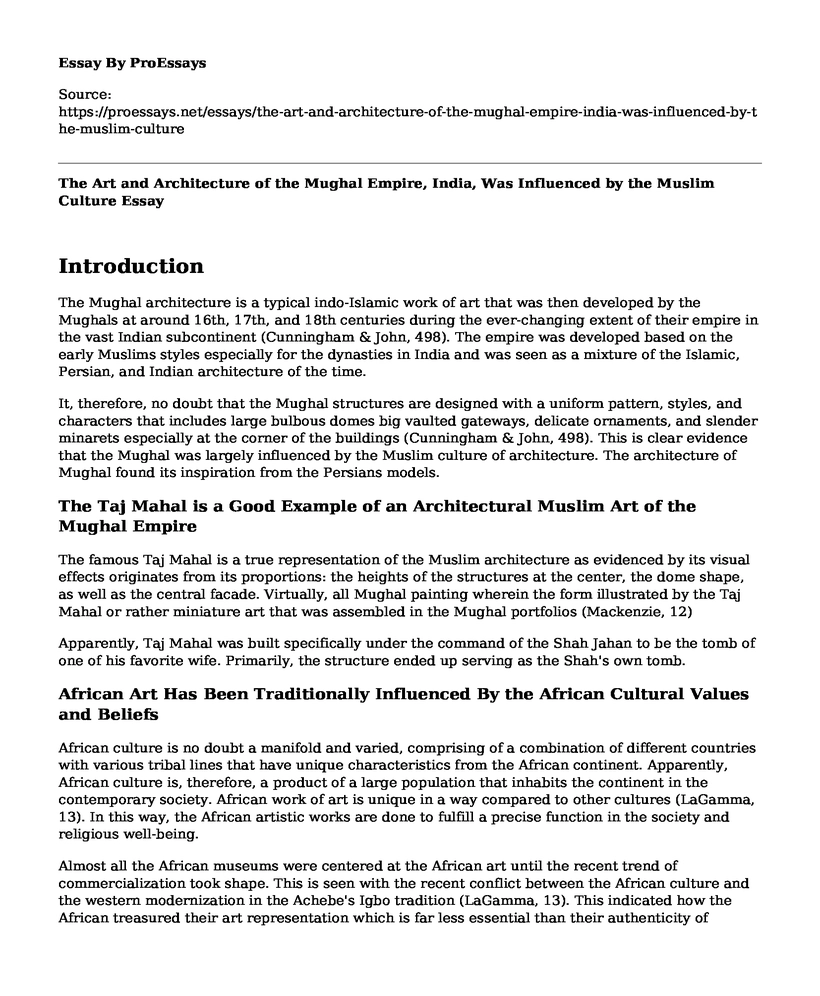Introduction
The Mughal architecture is a typical indo-Islamic work of art that was then developed by the Mughals at around 16th, 17th, and 18th centuries during the ever-changing extent of their empire in the vast Indian subcontinent (Cunningham & John, 498). The empire was developed based on the early Muslims styles especially for the dynasties in India and was seen as a mixture of the Islamic, Persian, and Indian architecture of the time.
It, therefore, no doubt that the Mughal structures are designed with a uniform pattern, styles, and characters that includes large bulbous domes big vaulted gateways, delicate ornaments, and slender minarets especially at the corner of the buildings (Cunningham & John, 498). This is clear evidence that the Mughal was largely influenced by the Muslim culture of architecture. The architecture of Mughal found its inspiration from the Persians models.
The Taj Mahal is a Good Example of an Architectural Muslim Art of the Mughal Empire
The famous Taj Mahal is a true representation of the Muslim architecture as evidenced by its visual effects originates from its proportions: the heights of the structures at the center, the dome shape, as well as the central facade. Virtually, all Mughal painting wherein the form illustrated by the Taj Mahal or rather miniature art that was assembled in the Mughal portfolios (Mackenzie, 12)
Apparently, Taj Mahal was built specifically under the command of the Shah Jahan to be the tomb of one of his favorite wife. Primarily, the structure ended up serving as the Shah's own tomb.
African Art Has Been Traditionally Influenced By the African Cultural Values and Beliefs
African culture is no doubt a manifold and varied, comprising of a combination of different countries with various tribal lines that have unique characteristics from the African continent. Apparently, African culture is, therefore, a product of a large population that inhabits the continent in the contemporary society. African work of art is unique in a way compared to other cultures (LaGamma, 13). In this way, the African artistic works are done to fulfill a precise function in the society and religious well-being.
Almost all the African museums were centered at the African art until the recent trend of commercialization took shape. This is seen with the recent conflict between the African culture and the western modernization in the Achebe's Igbo tradition (LaGamma, 13). This indicated how the African treasured their art representation which is far less essential than their authenticity of objects. Notably, this is a simple reason why people know few names of the African artists.
The Face Paintings of Maasai Warriors from Tanzania Express the Rich African Culture
The Maasai tribe of Tanzania is a perfect example of the rich African culture. Apparently, Maasai embodies a unique as well as a popular tribe as a result of their long preserved culture. Despite the modern civilization, and the western influences of cultures, the Maasai represent how Africans have clung to their cultures for decades now (Kasfir).
The Maasai distinctive cultural heritage, dress style, and face painting are a true representation of the African art of work that has stood the taste of times for many years. It is, therefore, important to note that tribal make-up or rather the facial painting plays an important role in the African cultural artistic works (Kasfir). The facial paints, especially by the Maasai, can signify various things such as hunting, religious, military purposes, and religious reasons, therefore, setting it apart from other work art.
Works Cited
Cunningham, Lawrence, and John Reich. Culture and values: A survey of the humanities. Thomson/Wadsworth, 2014.
Kasfir, Sidney Littlefield. African art and the colonial encounter: Inventing a global commodity. Indiana University Press, 2007.
LaGamma, Alisa, and John Pemberton. Art and Oracle: African art and rituals of divination. Metropolitan Museum of Art, 2000.
MacKenzie, John M. Mughal Empire. John Wiley & Sons, Ltd, 1983.
Cite this page
The Art and Architecture of the Mughal Empire, India, Was Influenced by the Muslim Culture. (2022, May 09). Retrieved from https://proessays.net/essays/the-art-and-architecture-of-the-mughal-empire-india-was-influenced-by-the-muslim-culture
If you are the original author of this essay and no longer wish to have it published on the ProEssays website, please click below to request its removal:
- Fictional Representations of Crime In TV Programs And Movies Greatly Influence What People Know About Crime
- My Passion About Playing My Guitar and How It Makes Me Feel - Essay Sample
- Design of a New Central Bank Essay
- 5-4-3-2-1 Structure: A Tonal Flux Journey - Research Paper
- Social Media Impact on Society, Relationships, & Attitudes - Essay Sample
- Movie Analysis Essay on A Night to Remember
- Social Influencers: Who are They & How Do They Influence? - Essay Sample







